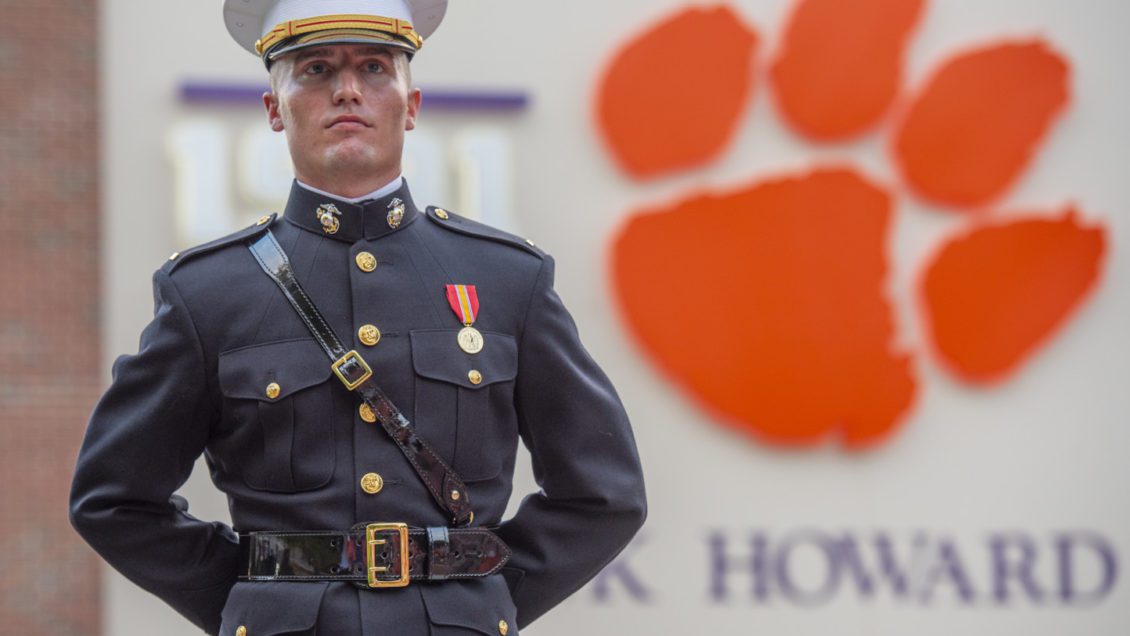In the early morning of February 2, three men met at Clemson University’s Alumni Center, where a minivan awaited them, wrapped front to back in bright orange and purple graphics with huge vinyl letters reading “Clemson Alumni” emblazoned across its doors. They weren’t looking for attention, and this van wasn’t exactly a subtle ride, but they had a job to do, so they piled in for the long drive to make a very special delivery.
Their mission was to make the three-hour drive east up Interstate 85 to a cozy assisted living home just south of Charlotte, North Carolina, and deliver a special American flag. It was the flag flown over Military Heritage Park for Clemson’s 2022 Military Appreciation Day, and the recipient was an old friend and cherished colleague, who they understood might or might not recognize them when they arrived. It was a miserably grey day, weather-wise, and the forecast only called for more rain, but this was a sacred task to each of them. Standing down was not an option.
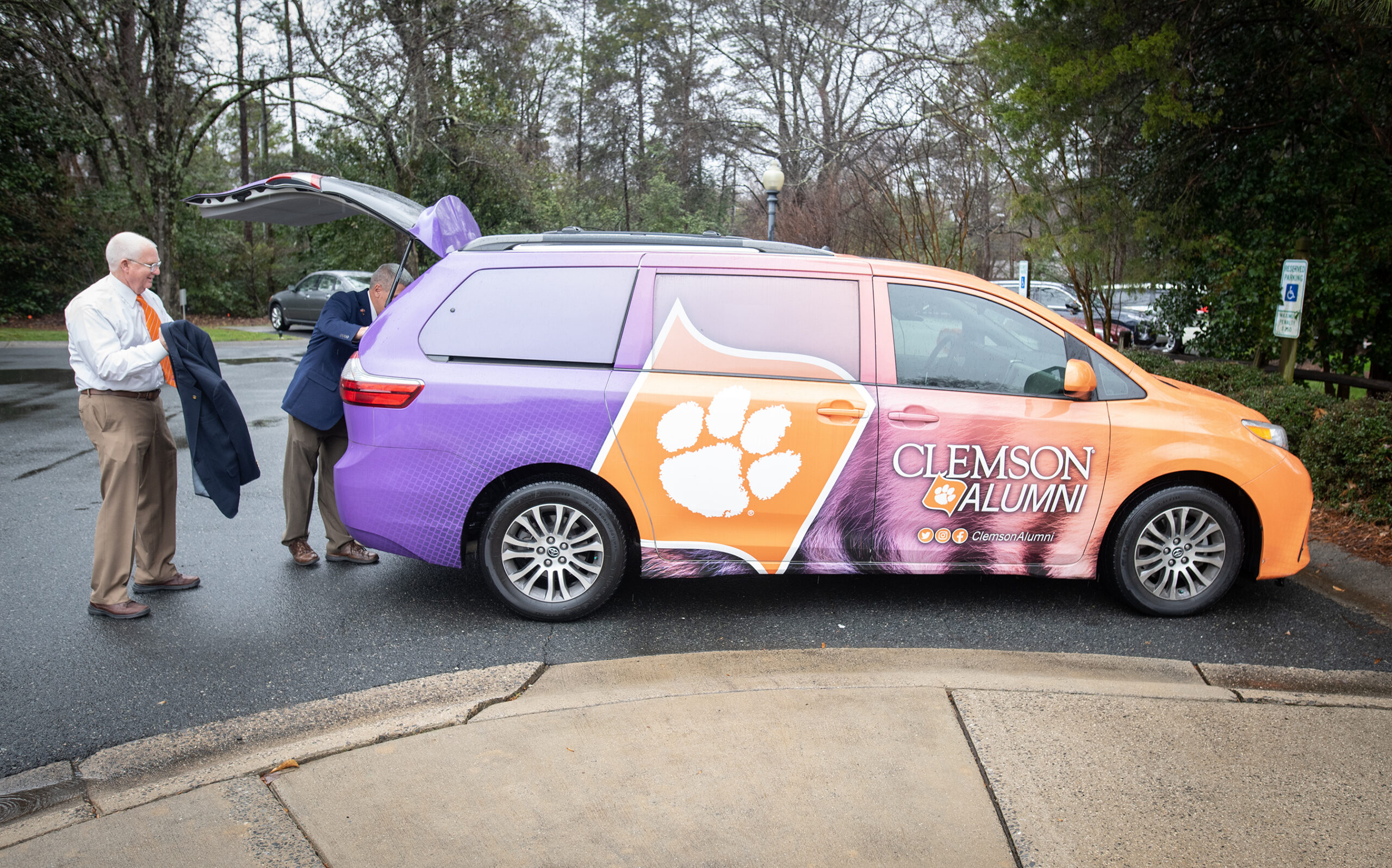
Retired U.S. Army Lt. Col. Jimmy Mullinax ’94 took the driver’s seat. Retired Air Force Col. Sandy Edge ‘72 sat on the passenger’s side, and retired Army Lt. Col. Bill Millar was seated behind him. As the van pushed through the storm, the men reminisced about their time at Clemson, all three having been commanders of their respective service’s Clemson ROTC programs — Edge and Millar during the same time in the late 1990s and Mullinax from 2012-2016.
The time passed quickly, and when they arrived, the clouds lifted.
Saluting a legend
Retired Army Lt. Gen. Gene Blackwell ‘63, M ‘65, the recipient of two Silver Stars and nine Bronze Stars and a recognizable Clemson legend, met them at the door. The man they had come to see was retired Air Force Maj. Bill Laffoday ’51, another former Clemson ROTC commander — in fact, he was Edge’s commander when Edge was an ROTC cadet. Laffoday was sitting in a wheelchair, waiting for them; his wife, Jean, and their three children flanked him.
Laffoday, who turned 94 three days earlier, sat quietly in his wheelchair as the group shifted around him. His memory had faded in recent years, but Edge kneeled next to his old friend’s chair and began to speak, regaling him with stories, one after the other. Laffoday’s face lit up with a smile, his family watched and listened, and when Mullinax presented him with the flag, he nodded in thanks. Time passed quickly once again for the Clemson entourage, but as the visitors prepared to return to their van, Laffoday shifted in his wheelchair and made his way to his feet, straightened his posture and saluted.

“I don’t know how you got him to do that!” remarked Laffoday’s daughter, Donna Clark. “It means so much that you came all this way to honor him.”
Together, the five men account for more than a century of military service. Those who have served know that there is no stronger brotherhood, but these men had another bond: They are the men of Clemson Corps — Edge, Blackwell, Millar and Laffoday being founding members and Mullinax, the current chairman.
The scene that played out that day perfectly encapsulates the story of Clemson Corps: fellow veterans rallying around one of their own to lift them up, no matter the obstacles.
It’s a story every member of the Clemson Family can be proud of.
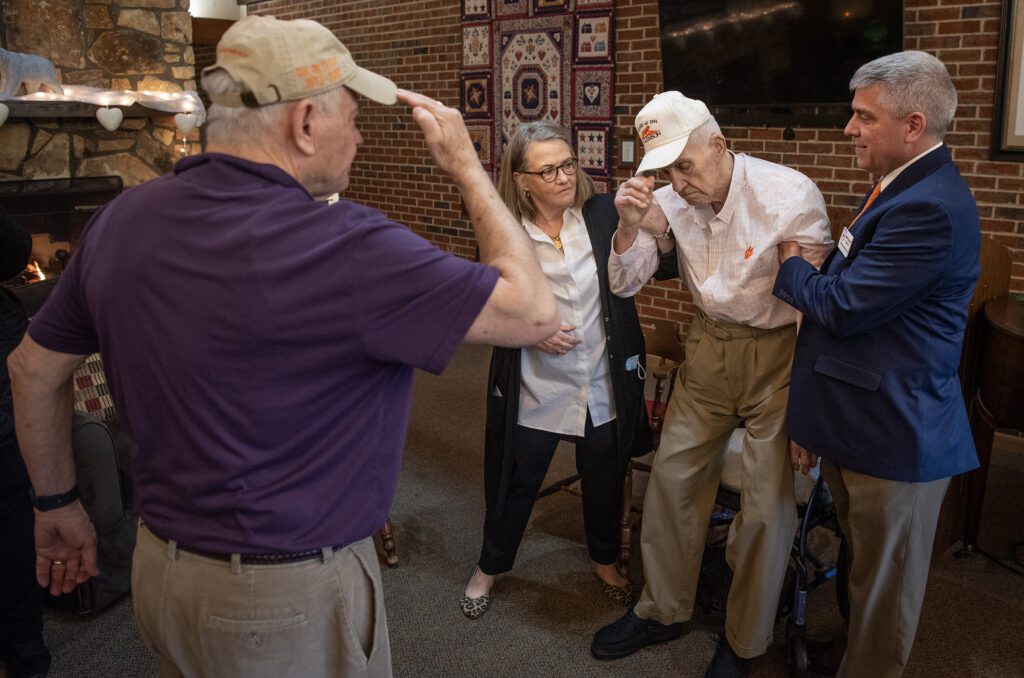
Saving a military heritage
More than 10,000 Clemson alumni have served in the armed forces. Each year, the University adds dozens to that list through its Air Force and Army Reserve Officers’ Training Corps programs, in recent years joined by a consistent number of two to four Marines — but until the late 1990s, there was no alumni group designed to support them.
After the dedication of the Military Heritage Plaza on June 6, 1996, members of the four classes (1950-1953) who planned and donated to the plaza realized much more could be done to support Clemson military veterans and started meeting in small groups to explore how to harness the energy of this steadily growing group of Clemson alumni.
These informal meetings became more earnest as the group quickly coalesced around the common goal of honoring Clemson alumni who served while supporting current students who are preparing to join the ranks.
Finding new purpose
In the mid-1990s, ROTC programs across the nation were facing low enrollment and budget cuts. At Clemson, commissioning numbers had declined considerably, with only 18 second lieutenants produced in 1997. University President Constantine Curris received a letter that year from the Department of Defense advising that the Army program was put on a two-year probation. If the detachment did not increase officer production, it could be terminated.
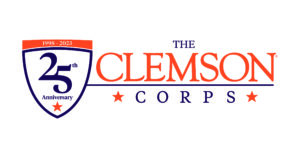
The founders of Clemson Corps were appalled that something like that was even a possibility at their alma mater. They made it their mission to keep that from happening by creating a formal group dedicated to elevating Clemson’s extraordinary military heritage and developing other opportunities to commemorate the University’s military history while forming endowments to supply scholarships to ROTC cadets.
“Memories fade as we grow older, but it’s easy to answer the question, ‘Why was the Clemson Corps formed?’” said Millar.
They knew what was needed: scholarship dollars for ROTC students and increased visibility on campus through events like Military Appreciation Day.
“A group of veteran alumni passionately wanted both ROTC programs to thrive and continue Clemson’s long history of producing outstanding officers to serve in the military,” Millar said. “Their hope was that an alumni organization could raise money to help.”
The first formal meeting resulted in a kickoff campaign, which started that September. Their first endowment, the Clemson Corps Quasi-Endowment, was established in April 1999 to assist grant-in-aid Air Force and Army ROTC students and to be used for other purposes deemed appropriate by the department. It is structured so that students from outside South Carolina accepted into Clemson’s ROTC program have their out-of-state tuition waived. To date, the Clemson Corps has provided more than $2.6 million in scholarships to more than 3,000 Clemson ROTC students from around the United States.
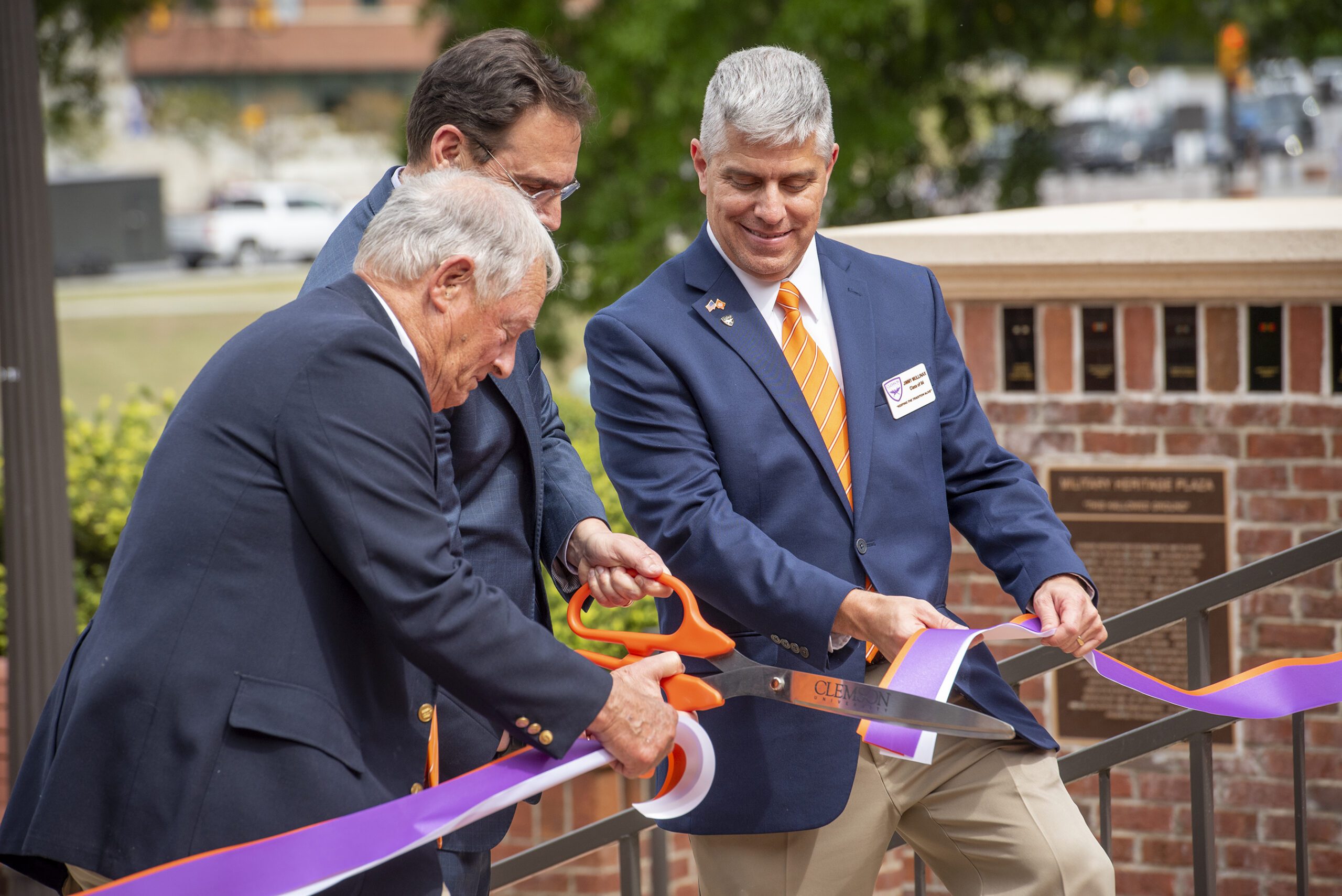
“I would say the magnitude of the endowments supporting scholarship programs under the umbrella of the Clemson Corps is a testament to the importance and respect alumni, current students, faculty and staff place on the role of the Clemson Corps,” said Air Force Col. Alton Whitely ’68. “I served as the secretary/treasurer of the Clemson Corps for eight years — the years from its infancy to its teenage years. I’ve been proud that we’ve had so many people step up and do what they could to make this program better and better each year.”
Etched in stone
In 2001, Clemson Corps took on what is perhaps their most notable project to date: the planning and construction of a memorial that honors Clemson alumni who made the ultimate sacrifice. Members gathered the names and stories of those men and put them on a portable frame that was moved from place to place on campus and called it the Scroll of Honor. The temporary scroll quickly came to be seen as less than ideal, so plans to find a suitable place on campus to construct a permanent memorial began.
They didn’t have to look farther than the University’s football stadium. In 1942, it was certified that it would be named Memorial Stadium to honor Clemson’s alumni who “have made the supreme sacrifice in the service of their country.” This drew the members of Clemson Corps to the area around the stadium, the most prime real estate on campus. It was a big ask, but Clemson Corps did not hesitate, and in 2006, they obtained the wholehearted approval from the Athletic Department to use the site upon which the Scroll of Honor Memorial now stands, directly across Williamson Road from Howard’s Rock.
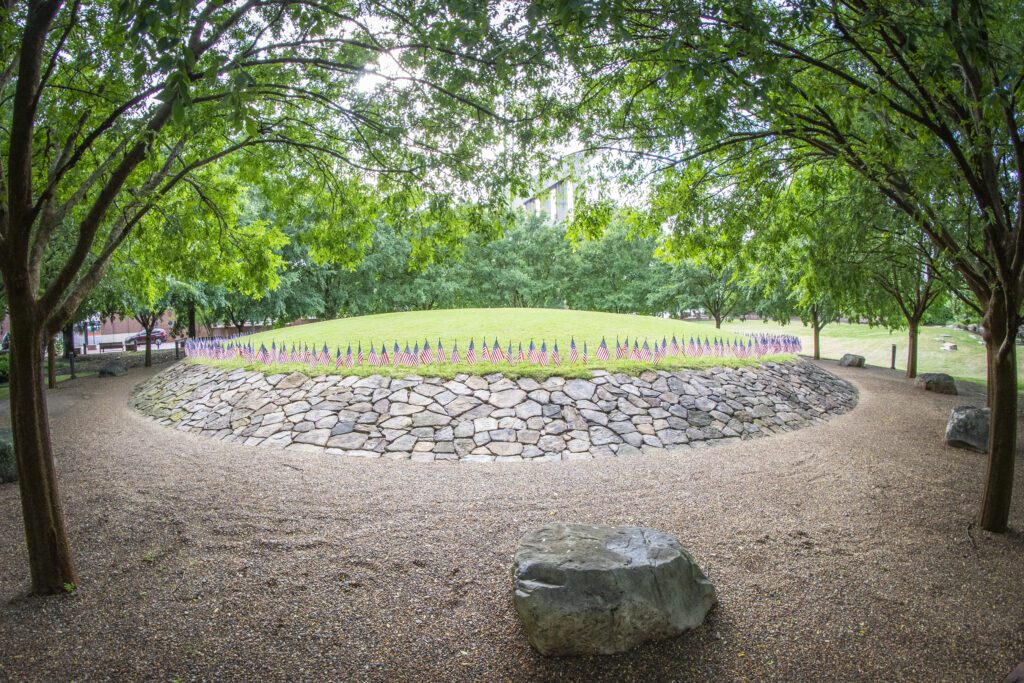
In March 2007, the Clemson Corps proposed the Scroll of Honor Memorial to the University Administrative Council and received unanimous approval to proceed. A memorial was designed that could serve as a place of reflection, with a round barrow ringed by stones engraved with the name and class year of each alumnus. This is enclosed by a circle of Chinese elm trees, which stand like sentinels on permanent watch, planted at angles to bow inward toward the grassy mound in homage to the honorees.
A capital campaign was launched that produced thousands of donations from alumni and friends of Clemson. Groundbreaking was held in September 2008, construction began in April 2009, and the memorial was dedicated in April 2010. It immediately became one of the crown jewels of the Clemson campus, attracting a steady stream of visitors 365 days a year. It also serves as a ceremonial focal point during each Memorial Day and Veterans Day.
“The Clemson Corps has accomplished many great things, and we plan to keep adding to that list, but the Scroll of Honor is one of our crowning achievements thus far,” said Edge. “It is more than a pretty place to members of the Clemson Family. It has a deeper meaning than Bowman Field, Kite Hill or even Death Valley because it is not just another landmark to us — it is a sacred place.”
Honoring service
“The Clemson Corps has a rich history here at Clemson. One of the most important things we do at Clemson is to prepare the leaders of our future, including our nation’s military through our ROTC programs. We are incredibly proud of Clemson’s Military Heritage and that our core University values reflect a commitment to patriotism and excellence. The members of the Clemson Corps not only uphold the values of our University but make it possible for the next generation of Clemson military veterans to do the same.”
Clemson University President James P. Clements
At the time of the Scroll of Honor Memorial’s dedication, there were 468 known Clemson alumni who died serving their country at war. Since then, more names have been discovered through meticulous research, bringing the current known number to 497. In 2012, Clemson Corps procured the 1.5-acre area around the Scroll of Honor and dedicated it as Clemson’s Memorial Park. It’s a serene space of rolling lawns ringed by oak, maple, cedar and cypress trees that becomes a place of quiet reflection even during game days when 81,000 raucous fans fill the stadium across the street.
Today, Clemson Corps is made up of 18 board members and hundreds of veteran alumni and friends. It plays a role in virtually every military event on campus, particularly the annual Military Appreciation Week and Game. During the wars in Iraq and Afghanistan, Clemson Corps widened its mission to include providing services to the resulting influx of student veterans and other military-related students.
“We’re wrapping our arms around student veterans because those who have served and are back deserve as much support as those just going in,” said Mullinax, the current Clemson Corps chairman. “Total numbers now might surprise people. We have about 400 student veterans and 300 ROTC cadets. If you count students getting the GI Bill, military spouses and other military-related students, that adds about another 700. That’s over 1,400 students who can use our support.”

